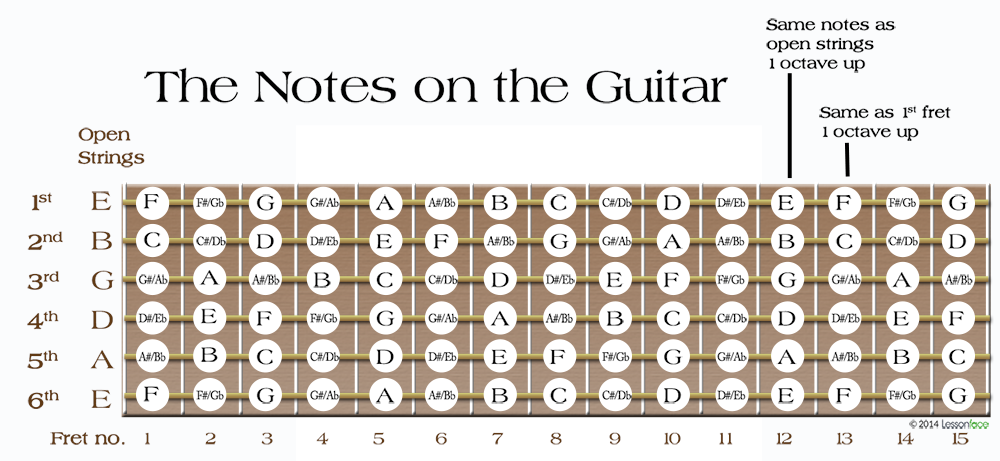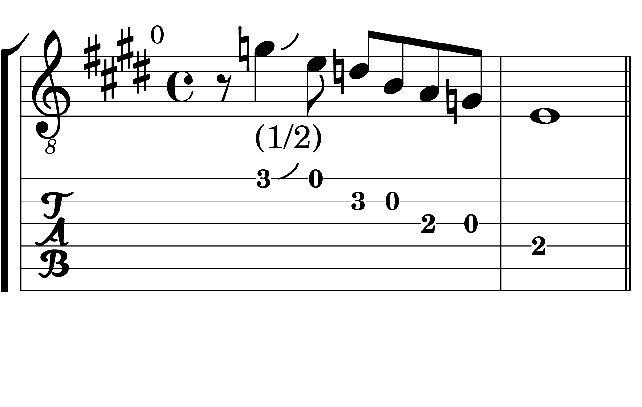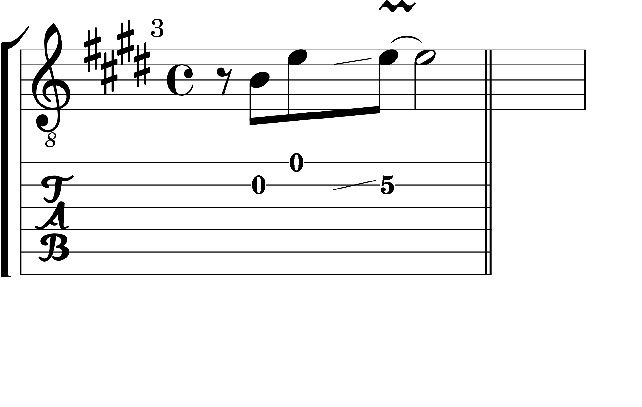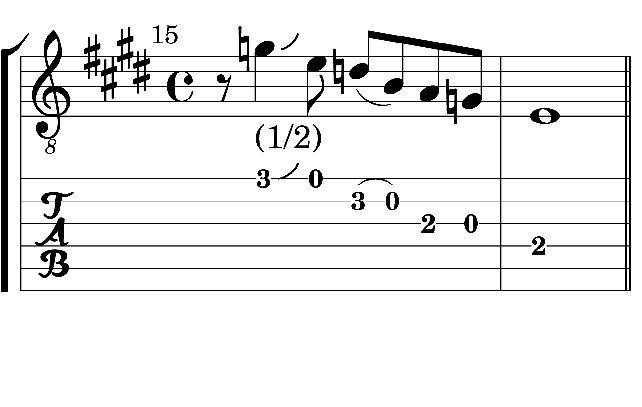Posted: Nov 13, 2015 3:34 pm
In the first part of my very brief overview of blues music I covered the typical structure - 12 bars based on I, IV, and V chords. I also posted a backing track that give the general idea of the musical foundation that a blues solo is often layered on top of- of course you can just play the blues solo without the rest.
One way of looking at the make-up of the blues solo is to see it as a concatenation of blues licks - I'm simplifying but that's the relevant part for where I'm going with this thread.
I think it best to present a few licks in the wild next just so we're all on the same page.
And here's Marty presenting a lick and showing how to use it along with a basic scale to play some blues. I posted this video because Marty shows how you start with a lick idea and then change it around, modify it, bury it with other licks and make something new - that's were I'm going with this thread.
In case you're new to guitars, here's the basics. Normal guitars have 6 strings. And although there are many ways to tune them, standard tuning, from lowest note to highest is, E (82.2 Hz.) A (5 semitones higher) D (5 semitones higher) G ( 5 semitones higher), B (4 semitones higher), E (5 semitones higher (and two octaves higher than the low E)).
Every fret up on the fretboard is a semitone higher. Here's the fretboard layout for standard tuning.

I'll be happy to go into this in more details if there's any interest. The internet and youtube makes this a lot easier to learn then it once was - especially if you have some help sorting through it all. (I'll just mention, if I post a guitar lesson from someone then I think they are great teachers and it's worthwhile checking out their other stuff - I have no affiliation with any of them.)
Now it's time to look at how a lick is represented musically. (ummm. many blues players learned by ear and never learned to read music but I'll be using music notation.
Because guitar tuning is such that there is usually more than one place to play the same note it is helpful to augment standard music notation with another notation that shows exactly where to play a given note. TAB is a guitar music notation designed to do just that. I'll be presenting licks in both standard notation and TAB, there are advantages to each of them.
Here's lick 0, that was in the founder set of licks that I linked to in the OP.

Standard music notation is directly above the TAB notation. From the standard notation we learn the key - signaled by 4 sharps here- so we're in the key of E (Just ask if you want a more detailed explanation of any of this.) The '0" is the lick name I'm giving it. It's to the right of the key signature. The "C" signals we're in common or 4/4 time. That means there are 4 beats to the bar and each beat has the duration of a quarter note. Everything else is pretty basic standard music notation which I imagine everyone is familiar with - but I can find some good links to explain it if necessary.
Below the standard music notation is the TAB staff. Unlike standard music notation where each line represents a note, with TAB each line represents a guitar string. The string tuned the lowest is represented by the lowest line, the string tuned the highest is represented by the highest line - well you get the idea. When we refer to these strings we number them from the top (1) to the bottom (6). (those numbers don't usually appear on TAB- you're just supposed to remember what the lines are refering to.)
The numbers on the line tell you which fret to press down, counting 0 as "open" or don't press anything and 1 as press down the first fret - and so on. Soooo the first 3 we see on the TAB is signaling to press down on the third fret of the high E string - also known as the first string.
But there's also a funny looking curly symbol next to the 3- that's a bend. Guitar players don't always just play the note that you get by fretting a string but sometimes also raise the pitch of that note by bending the string - this add tension and the note goes sharp. The 1/2 means - bend the note one semitone. a 1 would be a whole tone - two semitones - etc. There are lots of different little articulations like this used in blues, and other music, that gives the styles a certain flavor. I'll cover some of these and there notations next.
Lick 3:

The first thing to notice about lick three is that it's only one bar in length. The double lines signal the end of the lick. Then there's the / before the 5. That's an articulation that means to slide your finger into the 5th fret as you pluck the note. Finally, there's the little wavy symbol above the note on the standard notation staff - that means add vibrato to the note as it rings out- B.B King was a master at this. (It probably helped that he was a left handed guy playing a right handed.)
Lick15:

Lick 15 is very similar to lick 0 except that when you get to playing the notes on the second string you pluck the 3rd fret note and then pull you're finger off the fret in a way to make the open string note ring out. This is known as a pull-off. It gives a unique sound and it's one way to help play fast licks.
Similar but different from a pull-off is a hammer-on. So if the notes on the second string were reversed, that is, if you played the open note (B) followed by the third fret (D), then, for the notation I'm using, the same symbol would mean strike the open string and then hammer on the third fret with your finger to make the note ring. It's another unique sound and another way to play faster licks.
I'll stop there and cover some more notation as I go along.
Here's a more complete tutorial of TAB
And if anyone has some favorite licks, I'll try to incorporate them into the thread.
One way of looking at the make-up of the blues solo is to see it as a concatenation of blues licks - I'm simplifying but that's the relevant part for where I'm going with this thread.
I think it best to present a few licks in the wild next just so we're all on the same page.
And here's Marty presenting a lick and showing how to use it along with a basic scale to play some blues. I posted this video because Marty shows how you start with a lick idea and then change it around, modify it, bury it with other licks and make something new - that's were I'm going with this thread.
In case you're new to guitars, here's the basics. Normal guitars have 6 strings. And although there are many ways to tune them, standard tuning, from lowest note to highest is, E (82.2 Hz.) A (5 semitones higher) D (5 semitones higher) G ( 5 semitones higher), B (4 semitones higher), E (5 semitones higher (and two octaves higher than the low E)).
Every fret up on the fretboard is a semitone higher. Here's the fretboard layout for standard tuning.

I'll be happy to go into this in more details if there's any interest. The internet and youtube makes this a lot easier to learn then it once was - especially if you have some help sorting through it all. (I'll just mention, if I post a guitar lesson from someone then I think they are great teachers and it's worthwhile checking out their other stuff - I have no affiliation with any of them.)
Now it's time to look at how a lick is represented musically. (ummm. many blues players learned by ear and never learned to read music but I'll be using music notation.
Because guitar tuning is such that there is usually more than one place to play the same note it is helpful to augment standard music notation with another notation that shows exactly where to play a given note. TAB is a guitar music notation designed to do just that. I'll be presenting licks in both standard notation and TAB, there are advantages to each of them.
Here's lick 0, that was in the founder set of licks that I linked to in the OP.

Standard music notation is directly above the TAB notation. From the standard notation we learn the key - signaled by 4 sharps here- so we're in the key of E (Just ask if you want a more detailed explanation of any of this.) The '0" is the lick name I'm giving it. It's to the right of the key signature. The "C" signals we're in common or 4/4 time. That means there are 4 beats to the bar and each beat has the duration of a quarter note. Everything else is pretty basic standard music notation which I imagine everyone is familiar with - but I can find some good links to explain it if necessary.
Below the standard music notation is the TAB staff. Unlike standard music notation where each line represents a note, with TAB each line represents a guitar string. The string tuned the lowest is represented by the lowest line, the string tuned the highest is represented by the highest line - well you get the idea. When we refer to these strings we number them from the top (1) to the bottom (6). (those numbers don't usually appear on TAB- you're just supposed to remember what the lines are refering to.)
The numbers on the line tell you which fret to press down, counting 0 as "open" or don't press anything and 1 as press down the first fret - and so on. Soooo the first 3 we see on the TAB is signaling to press down on the third fret of the high E string - also known as the first string.
But there's also a funny looking curly symbol next to the 3- that's a bend. Guitar players don't always just play the note that you get by fretting a string but sometimes also raise the pitch of that note by bending the string - this add tension and the note goes sharp. The 1/2 means - bend the note one semitone. a 1 would be a whole tone - two semitones - etc. There are lots of different little articulations like this used in blues, and other music, that gives the styles a certain flavor. I'll cover some of these and there notations next.
Lick 3:

The first thing to notice about lick three is that it's only one bar in length. The double lines signal the end of the lick. Then there's the / before the 5. That's an articulation that means to slide your finger into the 5th fret as you pluck the note. Finally, there's the little wavy symbol above the note on the standard notation staff - that means add vibrato to the note as it rings out- B.B King was a master at this. (It probably helped that he was a left handed guy playing a right handed.)
Lick15:

Lick 15 is very similar to lick 0 except that when you get to playing the notes on the second string you pluck the 3rd fret note and then pull you're finger off the fret in a way to make the open string note ring out. This is known as a pull-off. It gives a unique sound and it's one way to help play fast licks.
Similar but different from a pull-off is a hammer-on. So if the notes on the second string were reversed, that is, if you played the open note (B) followed by the third fret (D), then, for the notation I'm using, the same symbol would mean strike the open string and then hammer on the third fret with your finger to make the note ring. It's another unique sound and another way to play faster licks.
I'll stop there and cover some more notation as I go along.
Here's a more complete tutorial of TAB
And if anyone has some favorite licks, I'll try to incorporate them into the thread.